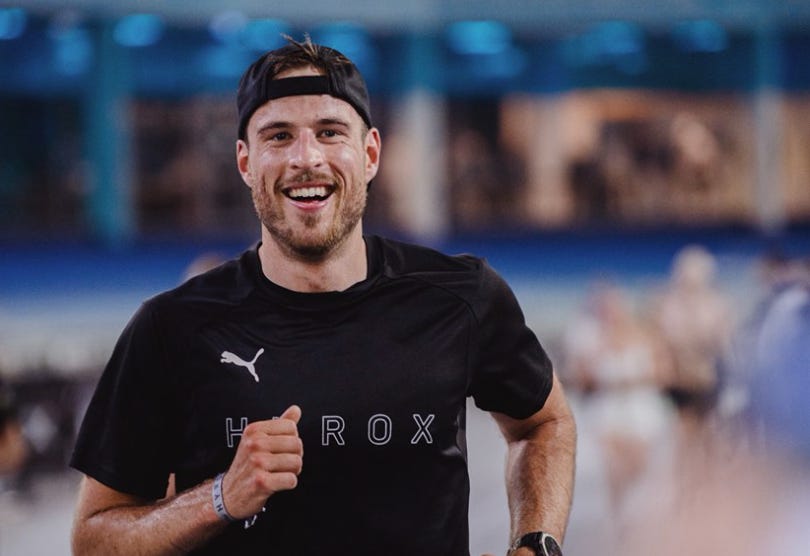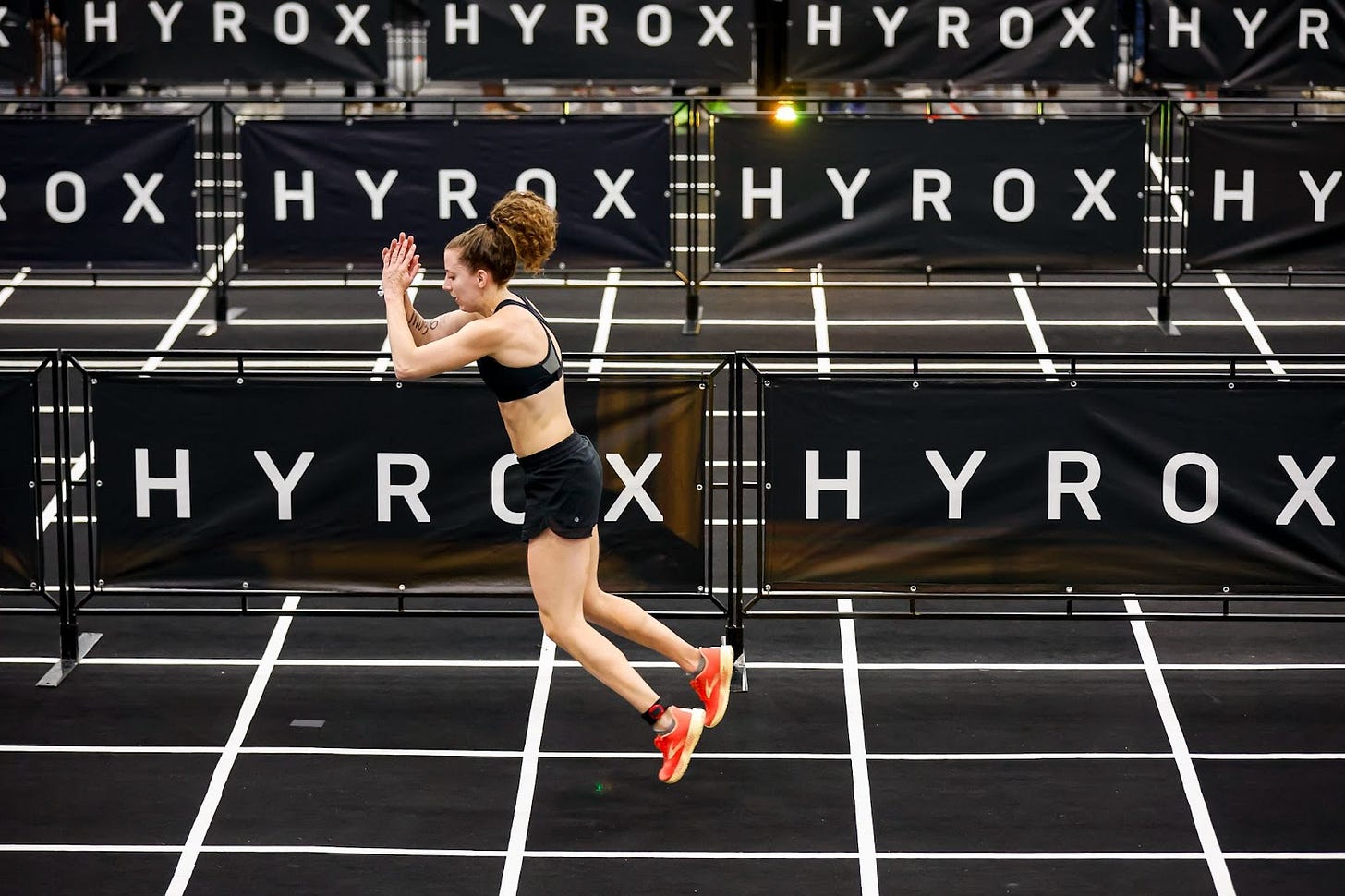The young gun of the Elite 15
At just 24, Hidde Weersma finished 7th at HYROX Worlds — and he’s only getting started
Hidde Weersma grew up near Rotterdam, bouncing between track, soccer, and hours in the gym before finding his way to triathlon—and eventually, HYROX. At just 24, he’s already one of the younger athletes in the Elite 15 and spends his professional life immersed in sport as a strength and conditioning coach for the Dutch Olympic Team. This past season, he finished seventh at the HYROX World Championships in Chicago with a time of 56:09, proof of his ability to blend strength, endurance, and race-day strategy.
The Hybrid Letter spoke with Hidde about trading triathlons for sleds and wall balls, the running volume that helped him climb the Elite 15, and how he’s learning to manage fatigue without losing his edge.
This interview was edited for length and clarity.
The Hybrid Letter: Can you start by telling us a little bit more about yourself and your athletic background?
Hidde Weersma: I’m from Spijkenisse, near Rotterdam in the Netherlands, and I still live there. I grew up with my parents and two sisters.
When I was younger, I started with track and field, then switched to soccer. I was never a great soccer player—pretty good at running up and down the field, but that was about it.
Around 14, I started going to the gym and loved it. I enjoyed learning strength exercises and getting stronger. Eventually I dropped soccer to focus fully on training. But I missed the competitive side of things—the conditioning, the structure.
My sister was with a local triathlon club, so I tried it. After a month I was hooked and ended up staying. That’s where I first learned how much I enjoyed the mix of endurance and strength. Eventually, I discovered HYROX and made it my focus.
Because I was so into training and performance, I studied Human Movement Sciences at a university in Amsterdam. I wanted to understand the physiology behind it all. Now sport isn’t just my passion—it’s also my work.
THL: After your first HYROX, what made you feel like it suited you?
HW: It was the running fatigue—what hybrid athletes call compromised running. That’s basically what I had trained for five years doing triathlons.
THL: Was anything about that first race surprising?
HW: The accumulation of fatigue from all the different exercises. Not that your body breaks down exactly, but the way fatigue builds across the workout really caught me off guard.
I’d done some rough calculations and figured it would take me about an hour. I finished in 1:04, so I was pretty accurate. I wasn’t too worried going in—triathlon training had prepared me for an hour-long effort. But as the workout went on, it got much tougher than I expected. That accumulation of fatigue was the biggest surprise.
THL: This season you started to see solo success alongside doubles. What shifted in your training?
HW: Most of my sessions stayed the same—I was already doing a lot of low-intensity endurance. What I changed were my hard sessions. I started doing longer threshold work, more specific intervals, and more total volume.
The easy answer is more meters on the SkiErg, more burpees, more of everything. I shortened intervals but raised the pace so I could focus on both speed and movement quality. Now I repeat sets more often to build volume.
THL: How does your training volume now compare to when you started?
HW: When I started HYROX, I was running about 50 kilometers a week. Now it’s closer to 70. Some people do much more, but I still make time for hours on the bike. It’s low impact, and honestly, I enjoy it the most. I ride outside whenever I can—indoors only if absolutely necessary.
THL: What was your strategy for the solo race at Worlds this year?
HW: I wanted to start hard, but not too hard. As more of an endurance athlete, I know going all out from the start doesn’t work for me. But I didn’t want to fall to the back either, so I pushed a little harder than normal but kept it in control.
The SkiErg is one of my stronger stations, but I held back. I can comfortably pull 1:43 or 1:44 without blowing up, just steady.
On the sled push, my plan was to keep it controlled—get it moving, then take short breaks every six meters or so.
For the sled pull, I wanted to make a move. It’s one of my best stations, and I can push hard there and still run well afterward. I think I moved up into fifth or sixth during the pull.
From there, I just locked in. That was the plan: start controlled, go big on the sled pull, and see how it played out.
THL: Looking back, was there anything you’d change?
HW: With the fitness I had on the day, I did everything right—no regrets. But I can see weak spots with the lunges and wall balls, so that’s what I’m focused on improving. I don’t think you should ignore your strengths while working on weaknesses, though.
THL: What’s your approach to injury prevention in long seasons?
HW: First, make a logical year plan. If you try to race every major, you won’t be at your best for the last chance qualifier or Worlds. You need to be realistic—plan when to peak and when to rest.
Then, during the season, the key is listening to your body. Easy to say, hard to do, but it’s essential.
THL: What do you enjoy about doubles?
HW: Doing it with someone else brings a whole new dimension. Normally I see myself as an individual athlete, but in doubles the dynamic changes—you run faster, the exercises move quicker, and the energy is just different. It’s a lot of fun.
THL: What are your goals for next season?
HW: With the majors, qualifying is always the big question. You can keep working on improving your time, but you can’t control what others do.
If I could choose, I’d do the majors in Hamburg and Warsaw, plus the last chance qualifier in London, and then hopefully Worlds in Stockholm. Those are the big ones.
For Elite Doubles, my partner and I want to hit Hamburg, Warsaw, and London as well, and then qualify again for Worlds.
You can follow Hidde on Instagram.
Is Hyrox training good for your health?
The official recommendation for adults is to engage in 75 minutes to 150 minutes of vigorous-intensity aerobic activity per week, or 150 minutes to 300 minutes at moderate-intensity.
Many Hyrox athletes, even at the recreational level, train many hours beyond these recommendations to prepare for their races. But is training for 10 hours or more weekly good for your health? A massive survey of 116,221 adults suggests that there are significant health benefits to higher training volumes.
A study published in the journal Circulation found that "adults who worked out two to four times more than the recommended amount of vigorous physical activity —about 150 to 299 minutes per week—were found to have 21% to 23% lower risk of all-cause mortality." Similarly, "who performed two to four times above the recommended amount of moderate physical activity had a 26% to 31% lower all-cause mortality."
Further, the study found that combining high levels of vigorous and moderate physical activity, as many Hyrox training programs do, provides the maximum benefit. People who combined high levels and vigorous and moderate activity saw "the maximum mortality reduction” of about 35% to 42%.
Athlete of the Week: Bree Schrader
Name: Bree Schrader
Age: 31
Hometown: Amarillo, Texas
Why did you start hybrid racing? I did my first DekaFit in August 2024 and my first Hyrox in March 2025. I ran competitively through college and afterwards, but started to get burnt out on road racing and thought hybrid races looked like a fun new challenge.
Favorite race to date? Houston Hyrox this spring. I wasn’t sure what to expect since it was my first one, but I had a ton of fun and really enjoyed the longer stations and runs versus feeling like I was constantly sprinting through the Deka stations.
Do you have a race goal? Qualifying for Hyrox Worlds next year in Sweden, hopefully at Dallas this fall.
Favorite station? Probably the sled push. As a smaller athlete it’s not my strongest station, but it’s way more fun than burpees or wall balls.
Least favorite station? Wall balls. I haven’t been able to get into a rhythm during races, so I’m really trying to nail those down before the next Hyrox.
What do you wish you knew before you started? How important it is to feel your effort on race day and be flexible instead of hyperfocusing on splits. I’m very in tune with how hard I can push on the runs, but I’m still working on knowing how hard is too hard on some of the stations. Also, how much footwear matters! I definitely underestimated how much the grip of race-day shoes can affect the sleds.



